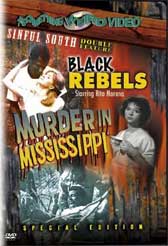 THE
BLACK REBELS (1960)/MURDER IN MISSISSIPPI
(1965)
THE
BLACK REBELS (1960)/MURDER IN MISSISSIPPI
(1965)The 60s were
the most turbulent decade for race relations in American history, with the civil
rights movement in full swing and meeting opposition nationwide. Of course,
as with every major news headline, the exploitation market latched onto this
important part of American history and produced a slew of race-relations films
well into the 70s and 80s. Something Weird presents two of the best early examples,
one a modestly budgeted and well-made high school drama, the other a sordid
and disturbing roughie. Combined together, this Sinful South (?) Double Feature
is one of the best surprises of the year from the most consistently excellent
cult DVD company out there.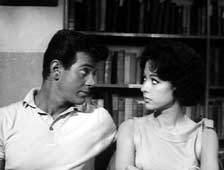
After a hate crime by a black gang against Buck Madison, the leader of a white gang, the juvenile division of the LAPD sends two rookie cops, Frank White and Don Walters, undercover as teenage hoods to infiltrate the two groups. Frank attempts to enter the Ebonys, the black gang, but because he’s half-Mexican, finds himself ostracized by both the Mexicans and the blacks. Don is assigned to join the Royals, Buck’s leather-jacketed white gang. In the midst of this undercover policing, young Hispanic Lola is in love with Jimmy, a white member of the Royals, a relationship kept behind closed doors because of Lola’s brother Manuel’s hatred for any non-Mexican men and the Royals’ blatantly racist philosophies. When Buck discovers the mixed-race love affair, he thinks he can use it to his advantage, as Manuel’s Mexican gang has been refusing to take part in Buck’s high school drug ring. But instead, Jimmy is accidentally killed and the blame is thrown on Manuel! Lola aims to expose Buck as the murderer, with the help of Frank and Buck’s recently spurned girlfriend Wiggles.
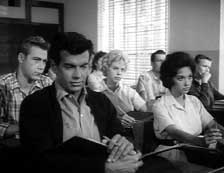 Originally
shot as THIS REBEL BREED and released as a pick-up by Warner Brothers in 1960,
THE BLACK REBELS found new life via the use of nudie inserts by producer William
Rowland and was re-released under that title, as well as LOLA’S MISTAKE
(the title on the accompanying trailer on the disc). As with a number of films
that exist only in their re-release form (SEEDS OF SIN, CONFESSIONS OF A PSYCHO
CAT), BLACK REBELS transforms from a surprisingly moving and captivating drama
to a flawed masterpiece. The inserts, basically consisting of random people
fondling one another, a lengthy section with an exotic veiled dancer dancing
on a table (!), and a topless swimming pool sequence, appear with little rhyme
or reason, sometimes interrupting tense dramatic moments. It’s a shame
the original version of the film, THIS REBEL BREED, isn’t more widely
available (you can get it from Sinister Cinema, and I highly recommend it!);
REBELS is still one powerful animal of a movie, but it’s tamed quite a
bit when the action switches to ludicrous sex scenes.
Originally
shot as THIS REBEL BREED and released as a pick-up by Warner Brothers in 1960,
THE BLACK REBELS found new life via the use of nudie inserts by producer William
Rowland and was re-released under that title, as well as LOLA’S MISTAKE
(the title on the accompanying trailer on the disc). As with a number of films
that exist only in their re-release form (SEEDS OF SIN, CONFESSIONS OF A PSYCHO
CAT), BLACK REBELS transforms from a surprisingly moving and captivating drama
to a flawed masterpiece. The inserts, basically consisting of random people
fondling one another, a lengthy section with an exotic veiled dancer dancing
on a table (!), and a topless swimming pool sequence, appear with little rhyme
or reason, sometimes interrupting tense dramatic moments. It’s a shame
the original version of the film, THIS REBEL BREED, isn’t more widely
available (you can get it from Sinister Cinema, and I highly recommend it!);
REBELS is still one powerful animal of a movie, but it’s tamed quite a
bit when the action switches to ludicrous sex scenes.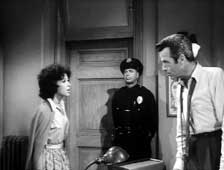
If the general storyline of the film sounds a tad like Albert Zugsmith’s HIGH SCHOOL CONFIDENTIAL, you wouldn’t be wrong, but unlike Zugsmith’s goofy mix of rock and roll, obnoxious teens, and drug dealing, Richard Bare’s film is much more serious and grave in tone. CONFIDENTIAL plays it safe and keeps a relatively clean and light-hearted approach to its subject matter, while REBELS is constantly throwing surprises at the audience. How many Hollywood films of this period show a white drug dealer selling marijuana cigarettes to little black kids? Or a guy impaling his head on a nail and perishing? Or a nasty teen taking a paintbrush and violently whitewashing a poor black man as his cronies hold him down? The dialogue is equally frank and disturbing, throwing around racial slurs and nasty behavior left and right. It’s no wonder Warner Brothers downplayed this one in its general release form. In addition to comparing REBELS to CONFIDENTIAL, contrast it with WEST SIDE STORY, with another similar concept. It’s like night and day. In fact, REBELS is, in my opinion, the superior film that, even with its flaws, has aged quite well. However, it may be hard to swallow the film’s message of racial equality when the only ethnic lead (Rita Moreno) is so light-skinned she could pass for white. The producers couldn’t even hire a black leading man, instead painting Mark Damon’s face a tan color to portray him as half-black, half-Mexican. Richard Laurier as Manuel, Lola’s fire-tempered brother, is another white actor posing as Hispanic. But the earnest performances and straight-faced tone of BLACK REBELS make this one of the true gems in Something Weird’s catalog, an exploitation film that exceeds the genre’s limitations.
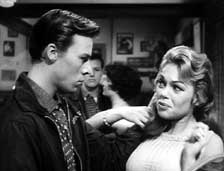 The
primary reason for REBELS’ success is the uniformly good cast. Sure, they’re
all in their late 20s playing high school students, but they bring these characters
to life splendidly. Two years before her Oscar win for WEST SIDE STORY, Rita
Moreno turns in a much more complex and interesting performance as Lola, the
self-loathing Mexican girl, than her much-lauded turn in Robert Wise’s
film. To my knowledge, Moreno has never publicly discussed her work in this
film, possibly because its only successful theatrical run contained nudie inserts,
but she’s dynamite here and it’s a good sign of what was to come
in her career. She also gets a good slap across a white bitch’s face!
Another future celeb, Dyan Cannon, plays Wiggles, the giggly flirt at Buck’s
side until her own secret is exposed and ruins her. She’s not used enough,
but Cannon is impressive in her handful of scenes. Unlike other films in the
exploitation genre, BLACK REBELS can’t really be seen as a skeleton in
either actress’ closet, and they should both be proud of this early work.
It’s hard to fault Mark Damon for his blackface get-up, because he tries
his best as Frank. He’s handsome, studly, and flashes his 50-watt smile
admirably. This was the same year he starred in Roger Corman’s dull FALL
OF THE HOUSE OF USHER before emigrating to Italy and starring in countless spaghetti
westerns. He’s now a successful film producer. Doug Hume, as Don, is equally
as dashing a leading man, but his career wouldn’t be as successful. Let’s
put it this way: when Rowland had to shoot the sexy inserts in 1965, he had
no trouble getting Hume to return and appear in them. No, he doesn’t disrobe,
but he does gawk at the topless girls and basically opens doors and says “Excuse
me” ad nauseum. The real star of the leading men is Richard Rust, the
intense actor who some may remember as the bewildered bellhop in HOMICIDAL,
or even later as the long-haired biker who knocks up Barbara Leigh in STUDENT
NURSES. Fans of TV westerns should recognize him from countless cowpoke guest
spots, but he proves his Method acting chops as the vicious and heartless Buck.
Kenny Miller (ATTACK OF THE PUPPET PEOPLE, BLOODSTALKERS) appears as a geeky
rich kid anxious to win Buck’s favor. Also: listen for stock music you
may remember from FASTER PUSSYCAT! KILL! KILL!
The
primary reason for REBELS’ success is the uniformly good cast. Sure, they’re
all in their late 20s playing high school students, but they bring these characters
to life splendidly. Two years before her Oscar win for WEST SIDE STORY, Rita
Moreno turns in a much more complex and interesting performance as Lola, the
self-loathing Mexican girl, than her much-lauded turn in Robert Wise’s
film. To my knowledge, Moreno has never publicly discussed her work in this
film, possibly because its only successful theatrical run contained nudie inserts,
but she’s dynamite here and it’s a good sign of what was to come
in her career. She also gets a good slap across a white bitch’s face!
Another future celeb, Dyan Cannon, plays Wiggles, the giggly flirt at Buck’s
side until her own secret is exposed and ruins her. She’s not used enough,
but Cannon is impressive in her handful of scenes. Unlike other films in the
exploitation genre, BLACK REBELS can’t really be seen as a skeleton in
either actress’ closet, and they should both be proud of this early work.
It’s hard to fault Mark Damon for his blackface get-up, because he tries
his best as Frank. He’s handsome, studly, and flashes his 50-watt smile
admirably. This was the same year he starred in Roger Corman’s dull FALL
OF THE HOUSE OF USHER before emigrating to Italy and starring in countless spaghetti
westerns. He’s now a successful film producer. Doug Hume, as Don, is equally
as dashing a leading man, but his career wouldn’t be as successful. Let’s
put it this way: when Rowland had to shoot the sexy inserts in 1965, he had
no trouble getting Hume to return and appear in them. No, he doesn’t disrobe,
but he does gawk at the topless girls and basically opens doors and says “Excuse
me” ad nauseum. The real star of the leading men is Richard Rust, the
intense actor who some may remember as the bewildered bellhop in HOMICIDAL,
or even later as the long-haired biker who knocks up Barbara Leigh in STUDENT
NURSES. Fans of TV westerns should recognize him from countless cowpoke guest
spots, but he proves his Method acting chops as the vicious and heartless Buck.
Kenny Miller (ATTACK OF THE PUPPET PEOPLE, BLOODSTALKERS) appears as a geeky
rich kid anxious to win Buck’s favor. Also: listen for stock music you
may remember from FASTER PUSSYCAT! KILL! KILL!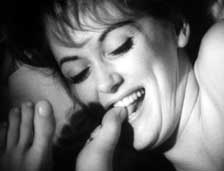
If you thought BLACK REBELS was controversial stuff, just wait until you see MURDER IN MISSISSIPPI! Following his OLGA series, the fake documentary CHAINED GIRLS, and the bizarre stripper parade THE PEEK SNATCHERS, director Joseph P. Mawra apparently had ambitions to direct a real dramatic work, and so MISSISSIPPI was the result. Loosely based on the appalling murder of three civil rights worker in Mississippi (the basis for the 1988 Hollywood film MISSISSIPPI BURNING), the film follows a group of young people into the wilds of Mississippi looking to register black voters to oust their racist government officials. White Southern belle Carol Byrd, white college student Bernie Samuelson, and black students Tyrone Carver, Sally Jones, and Luther Barnes run into the repulsive Sheriff Engstrom and his right-hand men, brothers Phil and Andy Loving. Luther is beaten bloody in the sheriff’s office and the group is warned to leave town. Ignoring the warning, Carol, Tyrone, and Bernie are arrested again and in an intensely violent sequence, the men are killed and Carol taken hostage by the Loving brothers. She is forced to call her movie star brother Dick and demand a ransom for her release; in the meantime, she becomes the sexual plaything of Phil, as he transforms her into a dirty, filthy degenerate begging for bites of greasy chicken in-between rape sessions. A daring escape attempt leads to the castration of her black rescuer, and when she’s back in the safety of her brother’s arms, she discovers that justice may be blind in the Deep South.
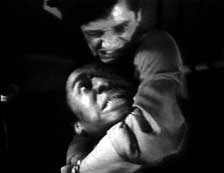 Shot
in the same upstate New York woods locations as OLGA’S HOUSE OF SHAME,
Mawra’s almost (gulp) socially responsible (!) roughie drama is yet another
exploitation film that exceeds what viewers and fans of the genre can expect
from the genius behind the just-plain-wrong OLGA films. It’s filled with
Mawra’s trademark shadowy noir lighting techniques, and the hand-held
camera allows for unique and awkward camera angles. Professional photography
shows up via nice use of tracking shots and claustrophobic close-ups. Producer
Herbert S. Altman also wrote the screenplay, which is a very well-done piece
of work, packed with hateful monologues and heartfelt arguments for racial equality.
Because this isn’t your ordinary New York roughie populated with strippers
and models, but genuine actors portraying flesh-and-blood characters, the violence
acted against the black men in the film is harder to watch without flinching
a number of times. Luther’s bloody beating is just a warm-up to the nasty
violence which continues throughout the film. The double-murder in the sheriff’s
office shortly after is one of the most profoundly disturbing sequences in any
film, let alone a sleazy little cult movie. Carol’s hostage situation
becomes more dire by the hour, and features some very disgusting moments. And
then, of course, is the castration, which together with PROSTITUTES PROTECTIVE
SOCIETY (shot the same year) poses a first in cinema history. It’s never
shown in graphic detail, but is so hatefully portrayed and vicious in nature
and presentation that it will linger in the viewers’ memory for some time.
And don’t get me started on the infuriating ending, geared to anger the
viewer because the crimes basically go unpunished. The most interesting scenes
actually don’t even involve the more exploitable elements of sex and violence,
but follow Luther and Sally as they talk to low-income black families about
registering to vote. These scenes don’t feel scripted, and have an air
of authenticity to them. However, they may be dismissed by viewers because they
are sandwiched between the disturbing scenes of rape and bigot violence. The
entire production is so mean-spirited that you may want to take a breather every
20 minutes to get some sunlight, but MURDER IN MISSISSIPPI is a prime example
of an exploitation filmmaker thinking ahead of his time and delivering a film
that could be digested by the sleaze-hungry 42nd Street audience as well as
less-discriminating arthouse snobs. It may be distasteful, but it’s a
historically valid and important film that probably couldn’t be appreciated
until now, over 30 years after its making. Some of its low-budget moments work
against the film’s favor, but in the end, it’s a pretty admirable
job from a man known for his S&M fetish vehicles.
Shot
in the same upstate New York woods locations as OLGA’S HOUSE OF SHAME,
Mawra’s almost (gulp) socially responsible (!) roughie drama is yet another
exploitation film that exceeds what viewers and fans of the genre can expect
from the genius behind the just-plain-wrong OLGA films. It’s filled with
Mawra’s trademark shadowy noir lighting techniques, and the hand-held
camera allows for unique and awkward camera angles. Professional photography
shows up via nice use of tracking shots and claustrophobic close-ups. Producer
Herbert S. Altman also wrote the screenplay, which is a very well-done piece
of work, packed with hateful monologues and heartfelt arguments for racial equality.
Because this isn’t your ordinary New York roughie populated with strippers
and models, but genuine actors portraying flesh-and-blood characters, the violence
acted against the black men in the film is harder to watch without flinching
a number of times. Luther’s bloody beating is just a warm-up to the nasty
violence which continues throughout the film. The double-murder in the sheriff’s
office shortly after is one of the most profoundly disturbing sequences in any
film, let alone a sleazy little cult movie. Carol’s hostage situation
becomes more dire by the hour, and features some very disgusting moments. And
then, of course, is the castration, which together with PROSTITUTES PROTECTIVE
SOCIETY (shot the same year) poses a first in cinema history. It’s never
shown in graphic detail, but is so hatefully portrayed and vicious in nature
and presentation that it will linger in the viewers’ memory for some time.
And don’t get me started on the infuriating ending, geared to anger the
viewer because the crimes basically go unpunished. The most interesting scenes
actually don’t even involve the more exploitable elements of sex and violence,
but follow Luther and Sally as they talk to low-income black families about
registering to vote. These scenes don’t feel scripted, and have an air
of authenticity to them. However, they may be dismissed by viewers because they
are sandwiched between the disturbing scenes of rape and bigot violence. The
entire production is so mean-spirited that you may want to take a breather every
20 minutes to get some sunlight, but MURDER IN MISSISSIPPI is a prime example
of an exploitation filmmaker thinking ahead of his time and delivering a film
that could be digested by the sleaze-hungry 42nd Street audience as well as
less-discriminating arthouse snobs. It may be distasteful, but it’s a
historically valid and important film that probably couldn’t be appreciated
until now, over 30 years after its making. Some of its low-budget moments work
against the film’s favor, but in the end, it’s a pretty admirable
job from a man known for his S&M fetish vehicles.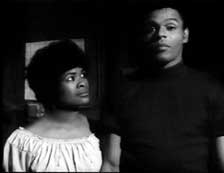
MISSISSIPPI is anchored by a cast of able performers, many of whom never did another film. I have a feeling most were recruited from local casting agents, and were right at home in off-Broadway plays or local commercials. Derrek Crane, for instance, is a terrifying presence as the immoral sheriff, who bends the law when he feels like it and considers the murder of a black man akin to the killing of an animal. Remember him from SIN IN THE SUBURBS? Probably not, because this is the role that should have led to him playing heavies in many other projects. Leading lady Sheila Britt (misspelled in the credits as “Shiella Britton”) is a familiar face to any fan of NYC sexploitation. She seems to have taken over in the role of reigning German sexpot when Gigi Darlene disappeared, making her mark in Joe Sarno’s THE SWAP AND HOW TO MAKE IT and continuing to make films with him and rarely anyone else. She was still going strong in 1969, when most every softcore starlet was disappearing, co-starring in SUBMISSION with future porno queen Jennifer Welles. She’s very good in this film, though her accent gets in the way at times. Doris Wishman’s regular stud, Sam Stewart, is Phil Loving, the rapist captor who degrades Carol to the basest human condition. As filthy as he is in the film, you just can’t help but notice how damn hot he is…! Wayne Foster appeared as another racist redneck two years after this film, in the unforgettable “Callie Sue” segment of THE HOOKERS, making life hell for poor Fleurette Carter. Does Dick Jones’ voice sound familiar as Dick Byrd, the smarmy actor brother of Carol? That’s because it’s really “Gaylord St. James”, the father from LAST HOUSE ON THE LEFT! A casting agent and actor based in New York, this may be his earliest screen role. He did lots of sexploitation films, including Andy Milligan’s FLESHPOT ON 42ND STREET, Doris Wishman’s DEADLY WEAPONS, and Roberta Findlay’s ROSEBUD! Working with so many great cult directors of the New York area, he probably has tons of great stories to relate about them! None of the black performers seem to have done other films (the sexploitation scene was still pretty much a white arena, with a few exceptions like Fleurette Carter), but Martin St. John (“Tyrone”) and Sally Jones (“Tina”) make the biggest impressions. Other noteworthy elements: Listen closely for library music memorable from PLAN 9 FROM OUTER SPACE! And it isn’t every grindhouse flick that ends with a shot of Lyndon Johnson saying “We shall overcome”!
Of the two transfers, BLACK REBELS looks better, with sharper black-and-white contrasts and a cleaner image throughout. Print quality doesn’t change between the inserts and the actual film. MURDER IN MISSISSIPPI looks good, but is generally soft and fuzzy, with a fair amount of dirt, debris, and print damage. The film is very dark, which could be because of the shooting conditions. Still, it’s good to have both films preserved on DVD for the ages, and fans will enjoy seeing them regardless of any print imperfections. The mono audio for both is surprisingly strong.
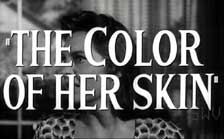 In
addition to a trailer for BLACK REBELS under its LOLA’S MISTAKE re-release
title, a collection of previews include even further race-relations controversy!
THE COLOR OF HER SKIN is a re-release trailer for THE NIGHT OF THE QUARTER MOON,
starring John Drew Barrymore and Nat “King” Cole (who looks to do
an impressive acting job). You can tell it was produced by Albert Zugsmith (HIGH
SCHOOL CONFIDENTIAL, GIRLS TOWN) because he landed many of the same cast members
from those films and his other productions: Cathy Crosby, Jackie Coogan, Ray
Anthony, Charles Chaplin, Jr., and Billy Daniels. It looks great! HIGH YELLOW
and FREE, WHITE AND 21 are the best films Larry Buchanan ever made, so if you
want to see another low-budget filmmaker aiming for greener pastures, check
both out! YELLOW features DON’T LOOK IN THE BASEMENT! co-stars William
Bill McGhee and Annabelle Weenick, and tells the tale of a black girl passing
for white. Bill Thurman plays yet another nasty racist redneck. Cynthia Hull,
the “high yellow girl”, you may remember had a giant hairdo resembling
a zit about to pop in Buchanan’s EYE CREATURES, and would move on to do
many guest spots on 60s and 70s TV. FREE, WHITE AND 21 was Buchanan’s
first courtroom film and is much better than the terminally boring TRIAL OF
LEE HARVEY OSWALD. It was also his first time working with William Bill McGhee.
The film’s gimmick was that the audience decides the verdict, but is a
well-made little drama worth checking out. Something Weird offers it on VHS.
I reviewed THE HOOKERS a few months back, and you can read my review on the
main page. But if you don’t feel like reading the whole thing, let me
sum up: a rather mediocre film saved by live-sound performances by three of
New York City’s best sexploitation starlets (Fleurette Carter, Sharon
Kent, Monica Davis) and an incredible opening 20-minute segment, highlighted
in the trailer, of Fleurette Carter’s painful flashback to being raped
by two rednecks in her backwoods hometown. MY BABY IS BLACK! was also recently
issued on DVD, and is a very good French import that is more at home in an arthouse
than a grindhouse. The director’s CHECKERBOARD, on the same DVD, is infinitely
better. A 1937 U.S. Department of Agriculture educational short, “The
Negro Farmer”, with Gospel spirituals and a unique look at poor black
farmers around this time (with actual location footage of low-income homes and
families), and the trusty Gallery of Exploitation Ad Art polishes off this winning
double feature disc! (Casey
Scott)
In
addition to a trailer for BLACK REBELS under its LOLA’S MISTAKE re-release
title, a collection of previews include even further race-relations controversy!
THE COLOR OF HER SKIN is a re-release trailer for THE NIGHT OF THE QUARTER MOON,
starring John Drew Barrymore and Nat “King” Cole (who looks to do
an impressive acting job). You can tell it was produced by Albert Zugsmith (HIGH
SCHOOL CONFIDENTIAL, GIRLS TOWN) because he landed many of the same cast members
from those films and his other productions: Cathy Crosby, Jackie Coogan, Ray
Anthony, Charles Chaplin, Jr., and Billy Daniels. It looks great! HIGH YELLOW
and FREE, WHITE AND 21 are the best films Larry Buchanan ever made, so if you
want to see another low-budget filmmaker aiming for greener pastures, check
both out! YELLOW features DON’T LOOK IN THE BASEMENT! co-stars William
Bill McGhee and Annabelle Weenick, and tells the tale of a black girl passing
for white. Bill Thurman plays yet another nasty racist redneck. Cynthia Hull,
the “high yellow girl”, you may remember had a giant hairdo resembling
a zit about to pop in Buchanan’s EYE CREATURES, and would move on to do
many guest spots on 60s and 70s TV. FREE, WHITE AND 21 was Buchanan’s
first courtroom film and is much better than the terminally boring TRIAL OF
LEE HARVEY OSWALD. It was also his first time working with William Bill McGhee.
The film’s gimmick was that the audience decides the verdict, but is a
well-made little drama worth checking out. Something Weird offers it on VHS.
I reviewed THE HOOKERS a few months back, and you can read my review on the
main page. But if you don’t feel like reading the whole thing, let me
sum up: a rather mediocre film saved by live-sound performances by three of
New York City’s best sexploitation starlets (Fleurette Carter, Sharon
Kent, Monica Davis) and an incredible opening 20-minute segment, highlighted
in the trailer, of Fleurette Carter’s painful flashback to being raped
by two rednecks in her backwoods hometown. MY BABY IS BLACK! was also recently
issued on DVD, and is a very good French import that is more at home in an arthouse
than a grindhouse. The director’s CHECKERBOARD, on the same DVD, is infinitely
better. A 1937 U.S. Department of Agriculture educational short, “The
Negro Farmer”, with Gospel spirituals and a unique look at poor black
farmers around this time (with actual location footage of low-income homes and
families), and the trusty Gallery of Exploitation Ad Art polishes off this winning
double feature disc! (Casey
Scott)